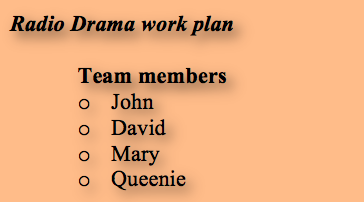
A story in a radio drama has a structure. Your radio drama will be made of scenes. A scene is where the time and place have changed. For example:
Scene 1: In the jungle, daytime.
Scene 2: In the tribe’s village, night-time
Scene 3: In the jungle, the next morning
Scene 4: At the waterfall, in the afternoon
Scene 5: In a museum, evening
To show there is a change in scenes you can use music, pause or sound effects too. Each scene in your Radio Drama should develop the story. That means that the story changes. In order to know how to develop a story we can refer to Freytag’s pyramid.
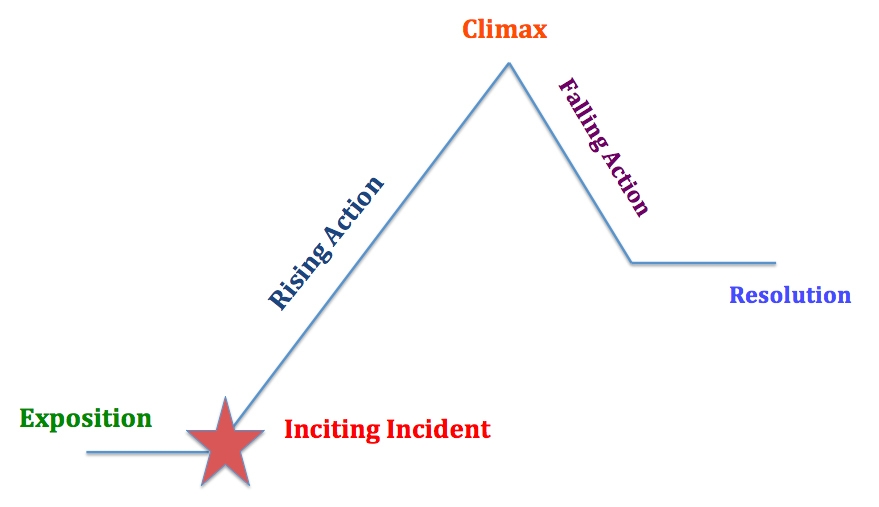
Take a look at the list and explanations below:
Exposition – showing the audience clearly the context of the radio drama.
Exposition should answer most of these questions:
- Where are the characters?
- Who are the characters (you don’t need to introduce them all)
- What time is it? (future, present, past, Christmas, morning, evening)
Inciting incident (a problem)
- What problem do the characters face?
- What problem needs to be solved?
- What ‘bad thing’ has happened?
Rising action
- The characters try to solve the problem
- The problem gets bigger
- The drama becomes more exciting
Climax
- The problem is solved – this can be good or bad. Not all problems are solved the way we wanted it!
Falling action
- What happens after the problem has been solved?
- How do people react and feel about what happened?
Resolution
- What has changed because of the problem and solution?
- What have the characters learnt?
- Is there a message for the audience?
These must be in the special order shown on Freytag’s Pyramid. The line going up and down shows the excitement, tension or suspense that the audience feels. Think about when you watch a Marvel film like Avengers.
Which part is the most exciting? Where would it be on Freytag’s pyramid?
Let’s look at an example from a short radio play called Late!
Have a look at the Exemplar section of this handbook. You should read the script ‘Late!’
Think about which parts of Late! match with the parts in Freytag’s Pyramid.
In this next section we will look at the structure of Late! This will help you when planning your own drama. Parts of Late! are here to show you how to do this.
Exposition – How is exposition shown in scene 1?
Scene 1
MTR Announcement: Please stand back from the platform screen doors. Beep beep beep beep beep beep.
Morgan: What time is it?
Jacky: 7:34am
Morgan: We are going to be late for the test.
Jacky: What happens if we are late for the test?
Morgan: If we are late for the test we will fail it.
Jacky: If we fail the test then our parents will be so angry and so will the teachers
____________________
This first part of scene 1 is the exposition. Why?
- It shows the audience where we are
- It shows the audience who the characters are
- It shows the audience the situation
We know that Jacky and Morgan are students (because they have a test), that they are young (because they are worried about what their parents and teachers will say) and that they are on the MTR in the morning (because of the MTR announcement and dialogue). This is exposition because it is clear to the audience where the Radio Drama is set and who the characters are.
It is important that exposition is clear and also natural. Look at the following example. What problems can you see? Does it sound real?
Scene 1
Morgan: Hello Jacky, my name is Morgan and we are on the MTR.
Jacky: Hello Morgan, yes we are going to school on the MTR in the morning.
Morgan: I am worried that we will be late because we have a test soon.
Jacky: I am eleven years old so I am worried about what my parents will say.
_____________________________________
Things to consider:
- Is this how you talk in real life?
- Does the audience need to use their imagination?
Exposition is important because the audience needs to know what is happening. Remember this:
Show, do not tell!
Look at these examples. Which ones are telling, and which ones are showing?
____________________________________________
Example A
Sam: I am 12 years old and I am at the beach.
______________________________________________________
Example B
Sound effect: a seagull squawks
Sam: Mummy, it is so hot. Can I have an ice cream? Look! There is an ice cream truck by the sea.
_________________________________________________
A is telling and B is showing. In example B the dialogue describes the weather, and the sound effect helps show the setting.
Let’s look at another example of this difference between telling and showing.
_________________________________________________
Example A
Kay: You are my teacher and I am a student.
_____________________________________
Example B
Sound effect: school bell ringing
Kay: (nervously) Hello Mr Chan. I am sorry, but I forgot to do my homework.
____________________________________________
In B we can see that sound effects and names such as ‘Mr Chan’ or mentioning ‘homework’ help with exposition. Have a look at the Exemplar scripts in this handbook. How is exposition used in scene 1 for each one?
Inciting incident
The inciting incident is the first problem that the characters face. It could be the start of a much bigger problem. What is the inciting incident in Late!?
Scene 1
MTR Announcement: The next station is Tin Hau. Doors will open on the left.
Morgan: Tin Hau. We have to get to Chai Wan.
Jacky: 7:35am
Morgan: How can we get to school faster?
Jacky: The MTR is too slow. How much money do you have?
________________________________________
Here the inciting incident is very simple: the students need to get to school faster. This is the problem that they face. They will have to find a taxi to get to school on time. Inciting incidents need to show problems and they need to be clear and interesting for the audience. The inciting incident can make more than one problem. Here are some ways to create inciting incidents:
- Accidents – for example a car crash
- Running out of time
- Running out of money
- Running out of resources, for example food or water
- Trying to find something
- Trying to find someone
- Trying to finish something by a deadline
- Trying to stop another character from doing something that is evil
- Seeing something very strange or unusual
Take a look at the Scene 1 from another example script called ‘Do Not Feed the Animals’. Can you identify the exposition and also the inciting incident?
Scene 1
Zookeeper: Good morning children! Welcome to Hong Kong Zoo!
All students: Good morning!
Zookeeper: My name is Jordan and I am a zookeeper here at Hong Kong Zoo. I see we have a question. Yes?
Sam: Hello, I am Sam. What is a zookeeper?
Zookeeper: A zookeeper is someone who cares for animals in a zoo. We give them food, water, wash them and also make sure they are safe and happy. Oh another question. Yes?
Jo: My name is Jo. Did a tiger ever try to eat you in the past?
Zookeeper: (laughing) No. We never get close to the tigers. Tigers look cute but they are dangerous. Any more questions?
Parker: Hello, my name is Parker. Can I please give my lunch to the tigers?
Zookeeper: (laughing) Sorry Parker, tigers have to eat a special lunch. You cannot feed the animals today.
Sam: What about a sandwich?
Zookeeper: Sorry, no feeding! It might be bad for the animals.
Parker: (whispering) I brought some chocolate and a mango for the tiger.
Jo: (whispering) I brought a cha siu bao for the dolphin.
Sam: (whispering) I brought a cheeseburger for the monkeys.
Zookeeper: Remember class, I need you to stick together. Hold hands! Do not give food to the animals. Do not feed the animals!
All students: Do not feed the animals!
Zookeeper: Follow me to see the monkeys.
_________________________________________
Which part shows the exposition? The inciting incident is underlined. The students want to feed the animals, even though they have been told not to. This is a problem, and the audience will want to know what happens next.
Rising action
Rising action shows a problem starting to be solved or a problem getting even bigger. One problem could become two problems. Have a look at scene 2 of Late! Here we see rising action as the taxi the students are in starts to fly!
____________________________________
Taxi Driver: (shouting) Do you like my car? I made it faster. Extra power!
Morgan: (shouting) It’s faster than a plane!
Taxi Driver: Oh, it can fly!
Jacky: What?
Taxi Driver: You want to fly?
Sound effect: car engine sounds like a plane and starts flying
Taxi Driver: Open the window! Enjoy the view!
Sound effect: wind blowing
Morgan: We are flying!
__________________________________________
The rising action is exciting! It can be surprising. It does not yet solve the problem.
Rising action can make the audience feel different emotions, depending on the genre of Radio Drama you are doing. A horror might make the audience feel nervous or scared. A romance might make the audience feel concern for a character’s romantic life. A science fiction story might make the audience feel excited and use their imagination more. In rising action you should really have the audience’s attention as you try to solve the problem!
Climax
The climax of the story is where the problem is solved. It can be positive or negative. Not all stories have happy endings! The inciting incident that creates problems at the start of the Radio Drama should be solved. Let’s have a look at the climax of Late!
____________________________________________
Taxi Driver: Right, let’s land here. Your school playground.
Sound effect: taxi/plane landing and engine turning off.
Taxi Driver: Thank you for flying with me. That’s $72, please.
____________________________________________
This is the climax because the students have solved the problem shown at the start of the Radio Drama: they have arrived at school on time. However, the climax is not the end of the drama. We need to see what happens after the problem is solved. This is called the falling action.
Falling Action
The falling action is not as exciting or tense as the rising action. Falling action may happen more slowly. Imagine an athlete finishing a race. The finish line was the climax, the falling action is what happens in the moments after crossing the line. It shows the audience how the characters react to the solution. What is the falling action in Late!?
______________________________________________
Morgan: Let’s go in the classroom
Sound effect: door opening
Jacky & Morgan: (slowly) It’s empty.
Morgan: I don’t understand.
Sound effect: school bell ringing
School Announcement: That is the end of the test for the school bell. Thank you.
Jacky: What time is it?
Morgan: 7:59am. We are one minute early.
Jacky: Wait.
Morgan: What?
Jacky: What day is it?
Jacky & Morgan: It is Saturday!
Morgan: Oh no. I thought it was Monday.
The falling action in Late! shows that Morgan and Jacky had made a mistake. They weren’t late for school – they were two days early! Here the falling action is funny.
Here are some other examples of falling action:
- How people feel after an accident has happened
- How people feel after the truth has been revealed
- What people do when a party or celebration has finished
- How people recover from a fight or war
Resolution
Resolution shows the final moments of the story. It helps the audience imagine what will happen to the characters after the radio drama finishes. It can also show a message or theme of the story. Let’s have a look at the resolution in Late!
__________________________________
Morgan: Let’s walk.
Jacky: Maybe we will see the taxi in the sky!
Morgan: Look there he is!
Sound effect: taxi flying in the sky
The End
__________________________________
The resolution here is that Morgan and Jacky are going to walk all the way home. That is a long way! However, this is still a happy ending because they did not miss the test. They also see the flying taxi again, reminding the audience of what happened earlier in the radio drama. Morgan and Jacky have experienced something that is unbelievable: that there is such a thing as a flying taxi.
Now that you’ve seen how an example radio drama is structured. The next part of this chapter will guide you through using Freytag’s Pyramid to design your radio drama.
Planning a Radio Drama using Freytag’s Pyramid
When you start planning a Radio Drama you need to make sure that you include everything on Freytag’s Pyramid. Here is the story plan for Late!
Exposition: Two students on the MTR in the morning.
Inciting Incident: The students will be late for school and they have an important test.
Rising Action: The students pay for a taxi to get to school more quickly. The taxi can fly!
Climax: The students arrive at school on time.
Falling Action: The students discover that it is Saturday and they are two days early for school.
Resolution: The students walk home and see the flying taxi in the sky again.
Here is another example using the script Do Not Feed the Animals.
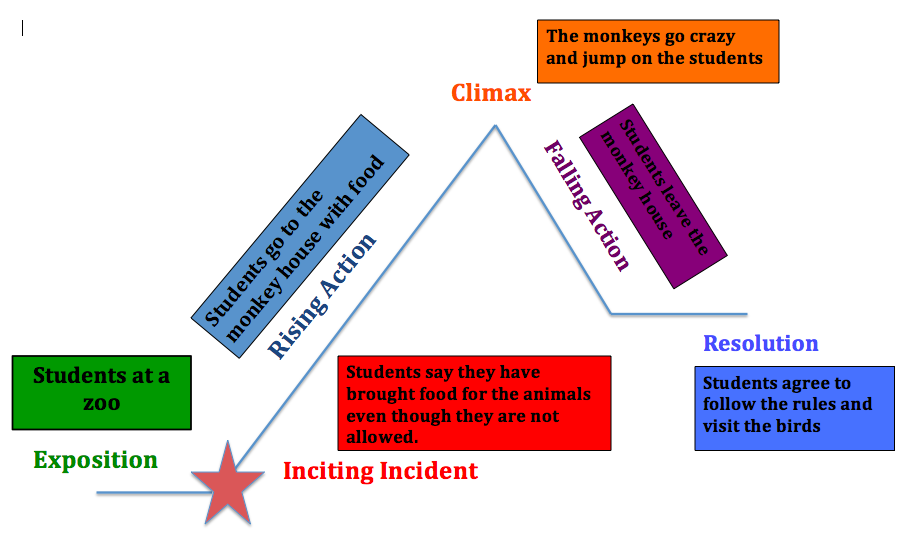
How many scenes?
If you follow Freytag’s Pyramid then your Radio Drama will have a clear story for the audience to enjoy.
Your time limit is 4-5 minutes, so you cannot have many scenes. Consider the following:
Scene 1: Exposition and Inciting Incident
Scene 2: Rising Action and Climax
Scene 3: Falling Action and Resolution
Remember, when you start a new scene, you must change the time or the place.
If you want to have more than three scenes then consider the following:
Scene 1: Exposition and Inciting Incident
Scene 2: Rising Action
Scene 3: Climax
Scene 4: Falling Action
Scene 5: Resolution
Make sure that you introduce the inciting incident in scene 1. The audience need to know what the problem is as soon as possible. This makes it more interesting and they will want to listen!
You can use Google Docs to plan your scenes. Use it to suggest and discuss ideas. Look at the examples below:
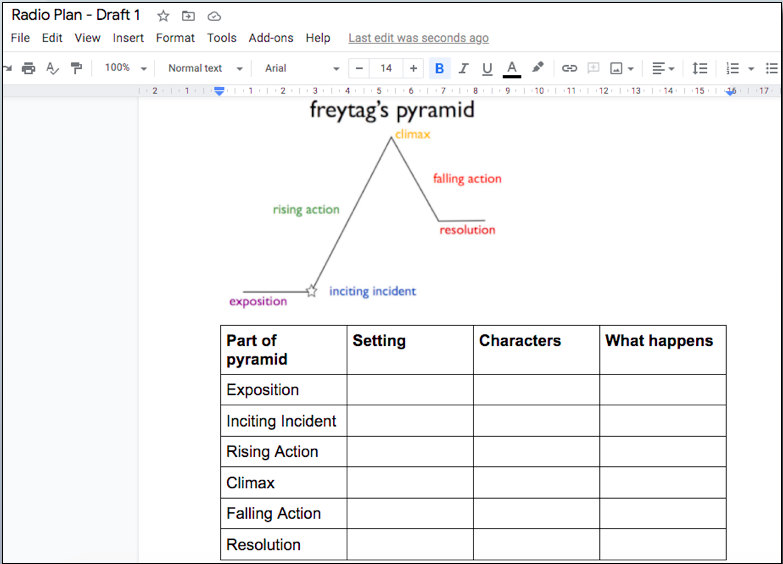

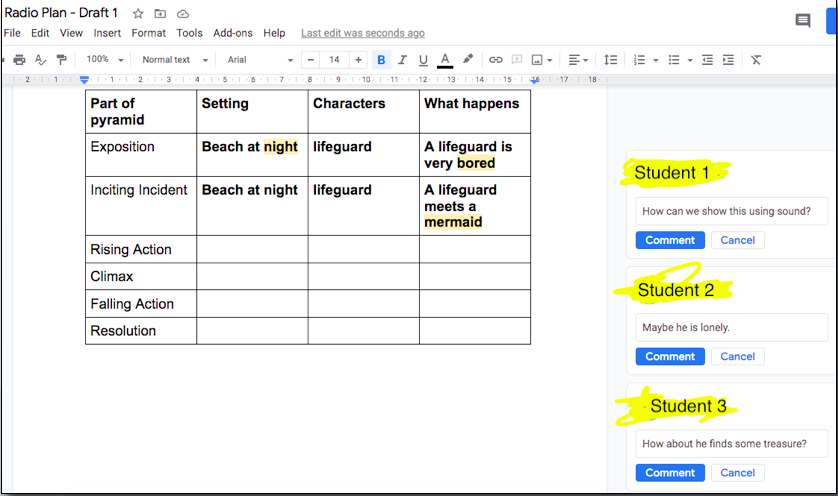
Remember, you don’t just delete what somebody else has written. You discuss it using the comment function. Once you agree, then you can change the text in the table!
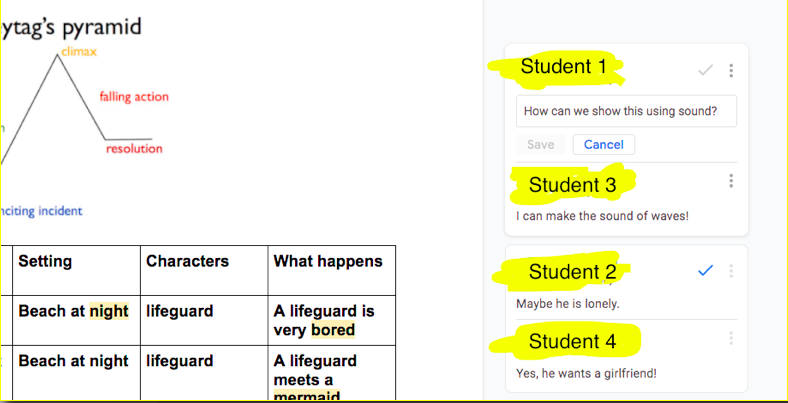
You can have a conversation about your Radio Drama politely and everybody gets to share their ideas.
Communication is important – look at the way Student 3 solves the problem of exposition by sharing that they know how to make a sound effect of waves.

Roles and responsibilities are also decided in a plan:
